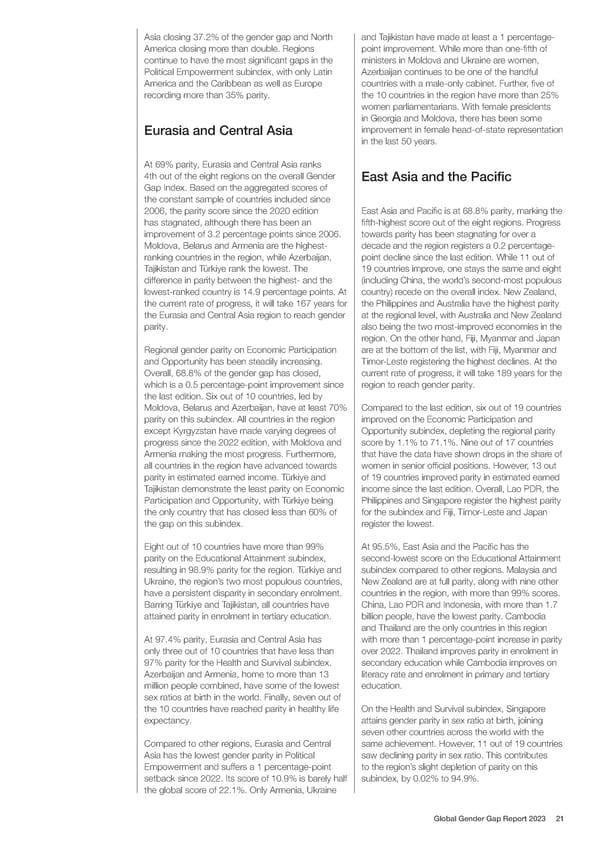Asia closing 37.2% of the gender gap and North and Tajikistan have made at least a 1 percentage- America closing more than double. Regions point improvement. While more than one-昀椀fth of continue to have the most signi昀椀cant gaps in the ministers in Moldova and Ukraine are women, Political Empowerment subindex, with only Latin Azerbaijan continues to be one of the handful America and the Caribbean as well as Europe countries with a male-only cabinet. Further, 昀椀ve of recording more than 35% parity. the 10 countries in the region have more than 25% women parliamentarians. With female presidents in Georgia and Moldova, there has been some Eurasia and Central Asia improvement in female head-of-state representation in the last 50 years. At 69% parity, Eurasia and Central Asia ranks 4th out of the eight regions on the overall Gender East Asia and the Paci昀椀c Gap Index. Based on the aggregated scores of the constant sample of countries included since 2006, the parity score since the 2020 edition East Asia and Paci昀椀c is at 68.8% parity, marking the has stagnated, although there has been an 昀椀fth-highest score out of the eight regions. Progress improvement of 3.2 percentage points since 2006. towards parity has been stagnating for over a Moldova, Belarus and Armenia are the highest- decade and the region registers a 0.2 percentage- ranking countries in the region, while Azerbaijan, point decline since the last edition. While 11 out of Tajikistan and Türkiye rank the lowest. The 19 countries improve, one stays the same and eight difference in parity between the highest- and the (including China, the world’s second-most populous lowest-ranked country is 14.9 percentage points. At country) recede on the overall index. New Zealand, the current rate of progress, it will take 167 years for the Philippines and Australia have the highest parity the Eurasia and Central Asia region to reach gender at the regional level, with Australia and New Zealand parity. also being the two most-improved economies in the region. On the other hand, Fiji, Myanmar and Japan Regional gender parity on Economic Participation are at the bottom of the list, with Fiji, Myanmar and and Opportunity has been steadily increasing. Timor-Leste registering the highest declines. At the Overall, 68.8% of the gender gap has closed, current rate of progress, it will take 189 years for the which is a 0.5 percentage-point improvement since region to reach gender parity. the last edition. Six out of 10 countries, led by Moldova, Belarus and Azerbaijan, have at least 70% Compared to the last edition, six out of 19 countries parity on this subindex. All countries in the region improved on the Economic Participation and except Kyrgyzstan have made varying degrees of Opportunity subindex, depleting the regional parity progress since the 2022 edition, with Moldova and score by 1.1% to 71.1%. Nine out of 17 countries Armenia making the most progress. Furthermore, that have the data have shown drops in the share of all countries in the region have advanced towards women in senior of昀椀cial positions. However, 13 out parity in estimated earned income. Türkiye and of 19 countries improved parity in estimated earned Tajikistan demonstrate the least parity on Economic income since the last edition. Overall, Lao PDR, the Participation and Opportunity, with Türkiye being Philippines and Singapore register the highest parity the only country that has closed less than 60% of for the subindex and Fiji, Timor-Leste and Japan the gap on this subindex. register the lowest. Eight out of 10 countries have more than 99% At 95.5%, East Asia and the Paci昀椀c has the parity on the Educational Attainment subindex, second-lowest score on the Educational Attainment resulting in 98.9% parity for the region. Türkiye and subindex compared to other regions. Malaysia and Ukraine, the region’s two most populous countries, New Zealand are at full parity, along with nine other have a persistent disparity in secondary enrolment. countries in the region, with more than 99% scores. Barring Türkiye and Tajikistan, all countries have China, Lao PDR and Indonesia, with more than 1.7 attained parity in enrolment in tertiary education. billion people, have the lowest parity. Cambodia and Thailand are the only countries in this region At 97.4% parity, Eurasia and Central Asia has with more than 1 percentage-point increase in parity only three out of 10 countries that have less than over 2022. Thailand improves parity in enrolment in 97% parity for the Health and Survival subindex. secondary education while Cambodia improves on Azerbaijan and Armenia, home to more than 13 literacy rate and enrolment in primary and tertiary million people combined, have some of the lowest education. sex ratios at birth in the world. Finally, seven out of the 10 countries have reached parity in healthy life On the Health and Survival subindex, Singapore expectancy. attains gender parity in sex ratio at birth, joining seven other countries across the world with the Compared to other regions, Eurasia and Central same achievement. However, 11 out of 19 countries Asia has the lowest gender parity in Political saw declining parity in sex ratio. This contributes Empowerment and suffers a 1 percentage-point to the region’s slight depletion of parity on this setback since 2022. Its score of 10.9% is barely half subindex, by 0.02% to 94.9%. the global score of 22.1%. Only Armenia, Ukraine Global Gender Gap Report 2023 21
 Global Gender Gap Report 2023 Page 20 Page 22
Global Gender Gap Report 2023 Page 20 Page 22